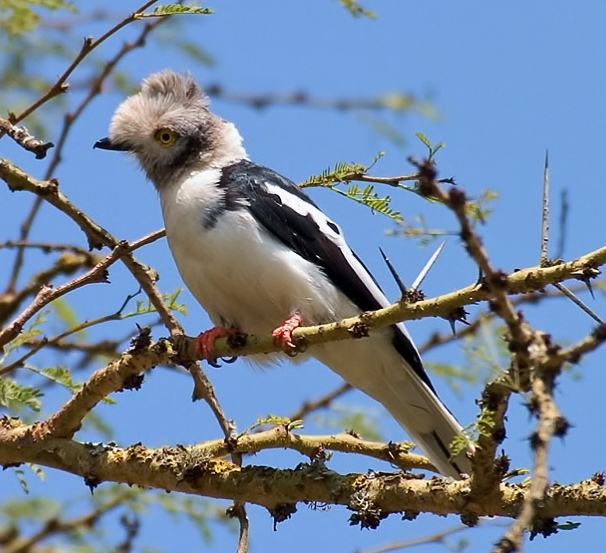 |
| (Photo from Bird Forum) |
Common name:
grey-crested helmetshrike (en); atacador-de-poupa-cinzenta (pt); bagadais à huppe grise (fr); prionopo crestigrís (es); grauschopf-brillenwürger (de)
Taxonomy:
Order Passeriformes
Family Prionopidae
Range:
This species occurs in a restricted area of south-western Kenya and adjacent areas of northern Tanzania, mostly between lake Victoria and lakes Natron and Eyasi.
Size:
These birds are 24-26 cm long and weigh about 50 g.
Habitat:
The grey-crested helmetshrike is found in open Acacia dephanolobium and Tarconanthus woodlands, riparian woodlands dominated by Acacia xanthophloea, Acacia abyssinica and Protea, and wooded grasslands and scrublands. They are present at altitudes of 1.200-2.200 m.
Diet:
They feed on insects, including insect larvae, grasshoppers and praying mantises.
Breeding:
Grey-crested helmetshrikes breed in April-July. They are cooperative breeders, living in groups of 12-17 individuals, all of which help build the nest, incubate the eggs, and brood and feed the young. The nest is an open cup made of bark and grasses and lined with spider webs which are also used to bind the nest to the branch of a tree. Each female lays 3-4 eggs, though more than one clutch may be laid in the same nest, and all group members help incubate them for 16-18 days. The chicks are fed by all group members, but there is no information regarding the length of the fledgling period.
Conservation:
IUCN status – NT (Near-Threatened)
This species has a relatively large breeding range and, although the population size of this species has not been quantified, it is described as generally scarce. The population is suspected to be in decline owing to ongoing habitat destruction and degradation, mainly due to increasing densities of livestock and cultivation of marginal land. Hybridisation with the white-crested helmetshrike Prionops plumatus may also represent a potential risk.







